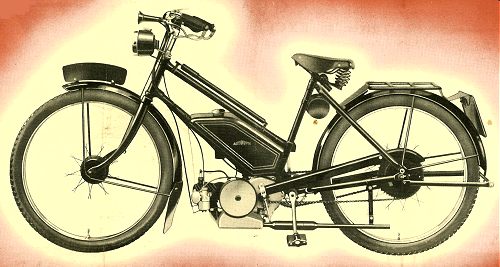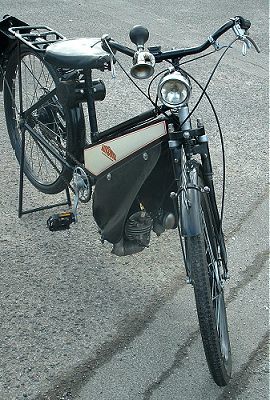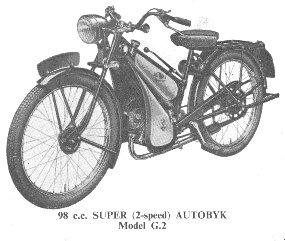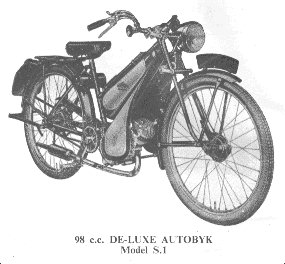 Go
to the Archive index
Go
to the Archive index
The shades of night were falling fast,
As thro’ an Alpine village passed
A youth who bore ’mid snow and ice
A banner with the strange device,
“Excelsior!”
Longfellow’s poem provided the inspiration for the trademark of Bayliss, Thomas & Co., which depicted the youth and his banner. Bayliss, Thomas & Co. were established in 1874 and were well-known makers of bicycles and tricycles at the Excelsior Works in Lower Ford Street, Coventry. Excelsior was only one of several trademarks used by the company but, by the time the Autobyk was launched, the name of the company had become "The Excelsior Motor Co. Ltd. (Proprietors of Bayliss, Thomas & Co.)" and the factory was at Kings Road, Tyseley, Birmingham 11. The Bayliss, Thomas name was still used for some exports since there were other companies in Germany and the USA which had rights to the Excelsior name; conversely, The Excelsior company in the USA had to put the name "American-X" on its motor cycles exported to Britain. Launched in 1937, the Excelsior Autobyk was one of the first two Villiers Junior powered autocycles, The other being the Raynal Auto. The story is that Villiers were worried about Raynal’s selling potential so, much to Raynal’s annoyance, they ‘leaked’ the design to Excelsior to ensure sufficient sales.

1938 Excelsior Autobyk

1940 Excelsior Autobyk de Luxe
Early Excelsior Autobyks were unsprung, with a short fuel tank that incorporated a separate oil tank. No engine covers were fitted but there was a round tool box between the seat tube and seat stays. Inverted handlebar levers controlled both brakes. A back-pedalling mechanism for the rear brake was introduced later. The price of an Autobyk in 1939 was 18 gns [£18.90]. In 1940, a second model of Autobyk - the de Luxe - was introduced. This had a larger fuel tank, engine covers, and a telescopic fork.
After the war, production of the Autobyk continued, now including engine covers and a pressed-steel spring fork as standard. The Autobyk was finished in black with crean panels on the tank sides and the engine covers. The price in March 1946 was £35 15s plus £9 13s 1d Purchase Tax [£35.75 + £9.65] but, because of the difficulties in obtaining raw materials in the immediate post-war period, this price could not be held and was increased to £39 10s (P.T. £10 13s 4d extra) [£39.50 + £10.67] on 17th June.

When the 1947 models were announced in August 1946, the Villiers-powered Autobyk had been given the model number 47/V1 and a new model had been added to the range: the Super-Autobyk, at first given the model number 47/S2 but re-designated 47/G2 in November. This did not use the Villiers power unit but had Excelsior’s own 98cc ‘Goblin’ engine incorporating a two-speed gearbox. Excelsior’s engine was equipped with an Amal 359/001B carburettor and Miller FWX flywheel magneto that also powered a 9W direct lighting set. The recommended petrol to oil ratio was 20:1 and the tank would hold 11 pints of fuel. The price of the Super-Autobyk was set at £48 10s (P.T. £13 1s 11d extra) [£48.50 + £13.10]. A useful feature incorporated into the Autobyk at this time was that the carrier, rear numberplate and part of the rear mudguard could be easily removed in one piece to give access to the rear wheel. A new spring fork was introduced with the 1947 models; this had fork blades each made of a single Reynolds 531 tube and used four rubber bands to provide the springing. Again, raw materials prices were reflected in the price of the autocycles when, in March 1947, they were increased to £45 for the 47/V1 and £55 for the 47/G2 (P.T. was extra on both these). The Super-Autobyk was the only British production autocycle to feature a 2-speed gearbox.

At the end of May 1947 yet another autocycle was added to the range. The Model 47/S1 Autobyk de Luxe was powered by Excelsior’s ‘Spryt’ engine, which was the same as the Goblin except that it did not have a gearbox. The new model retailed at £47 10s plus £12 16s 6d P.T. [£47.50 + £12.83].
Prices of the Excelsior powered models remained stable until 1951 although the Villiers powered machine was increased in price to be the same as the 48/S1 during 1948. In 1949 Villiers replaced the Junior de Luxe engine with the 2F. Other manufacturers redesigned their autocycles to incorporate the new engine; Excelsior dropped the Villiers model from their range and carried on with their own engines only.
For the 1950 models, the flywheel magneto was changed to the Wipac ‘Genimag’. This provided 21W lighting power and enabled the fitting of an 18/18w dipping headlight: the Autobyk was the only British autocycle so equipped. Until early 1953, the light switch was remotely operated by Bowden cable from a lever; late 1953 and subsequent models had the more conventional arrangement of a main switch on the headlamp shell and a handlebar mounted dip switch. When the 1952 range of Excelsiors was announced in September 1951 it was stated that the S1 de Luxe Autobyk would remain in black & cream but all other models would be maroon & cream, the implication being that 1952 G2s were painted maroon. However, a March 1952 review of autocycles lists both Autobyks as being finished in black. The evidence of surviving machines shows that practically every one was black. However, there is at least one existing machine in beige - a colour that was used on other motor cycles in Excelsior’s range.
As the 1950s progressed, the autocycle market dwindled in favour of the new under 50cc mopeds. The two Excelsior models were dropped from the range in 1956.
The next article in this series will describe the Francis Barnett Powerbike.
First published - October 1998
Revised - November 2006